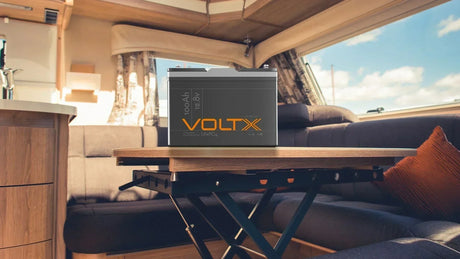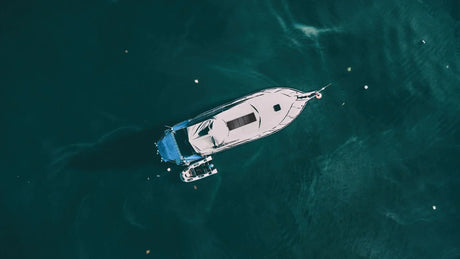Your lithium-ion battery needs ultimately depend on your camping style.
If you only stay at a powered campsite, then most of the standard lithium ion batteries will be enough for your outdoor needs. After all, you only need enough portable power to run your camper van systems when you stop for a break, en route. Some holiday parks and temporary sites have low-power hook-ups, so you may want to check this detail first when choosing a holiday park to do your stopover.
Then you have those camper van-ners who regularly stay for a night or two en route to their campsite of choice. But these holiday goers still want all the comforts of home with them, including a microwave oven that can be powered by an inverter. These inverters generate a ˜mains' AC voltage and the more expensive pure sine wave variants also match the shape of the mains voltage. The cheaper quasi-sine wave units may work with all equipment, so check before buying.
Typically inverters are used for powering phone and laptop chargers, where a 150W unit should be enough for your needs. If you are charging an electric bike for instance, then look at a 600W inverter. If you want a microwave, you will need to use an inverter of around 1,500W to power it, which will use 125A so you'll need beefy cabling to handle this.
Even a 600W (output) microwave will still take nearly 90A from a leisure battery via the inverter. If this is your lifestyle then probably two 100Ah batteries will be required to support such an inverter and microwave combination, even if you're only using it to warm pasties!
Moving up from this scenario are those motorhomes that wild camp a little more often. They need to consider how much battery energy they require and how much they can carry. To quantify how much energy, or how many amps, is needed; one first needs to convert all the outputs into amps, as we quantify batteries in ampere-hours (Ah). To do this, you must divide the wattage figure by the voltage (12V in this case). Once you have this figure you can start to consider batteries.
Quality deep-cycle batteries would be best. Lead acid batteries have a finite cycle life and these are best protected by not draining them down to more than half of their total stored ampere hours. Life cycle figures are given for this 50% depth of discharge figure (DOD). So, in reality, a 100Ah battery should be considered to be only a 50Ah battery. Lead acid batteries are made to a price and the cheaper batteries will have a shorter service life and fewer life cycles.
The final scenario is the frequent wild camper. To keep going in this scenario you need a reliable source of power, of which solar panels are ideal.

Solar panels are super quiet we all know that, so choose the biggest system you can get (afford). Make sure you have the appropriate MPPT (maximum power point tracking) solar regulator to maximize the panel's output and match the battery technology and, if required, a regulator that can charge both leisure and starter batteries.
It's also worth considering a battery-to-battery (B2B) charger, which takes power from the starter battery when the engine is running to charge the leisure battery faster than a conventional split charge relay.
If your motorhome has an ˜intelligent alternator' that converts braking energy into electrical energy to fast charge the starter battery then your motorhome may have a B2B unit already installed.
These are tailored to suit different types of batteries, so choose wisely if you see one of these as a method of quickly recharging your leisure battery during 60 minutes of engine running.
Take note of your power-guzzling items
When considering batteries, be aware of devices that take lots of amps:
Diesel-powered heater Any diesel heating system, water or space, has a pump to squirt diesel through a small jet to make a mist and a glow plug to light this mist. Glow plugs can take 20A for several seconds each time the heater is started and this happens frequently because of the thermostat. The diesel pump and a fan are also running all the time the heater is burning and consuming from 1A to 3A.
Compressor camping fridge These are more efficient than a three-way gas fridge but take a lot of power from your lithium ion battery, typically 5A when running under thermostatic control. So they work out at around an average of 2A if you don't want too much cold beer. If you simply multiply the amps taken by the hours running you have the ampere hours consumed. This is 24 (hours) x 2 (A) = 48Ah a day. Top-loading compressor fridges are the best of this bunch.
Lighting is no longer power-hungry and LED lighting is by far the most economical. A 2W LED lamp (taking only 0.17A) will provide similar illumination to a 20W quartz halogen bulb. By comparison that 20W halogen bulb would take 1.7A 10 times as much current.
For heating systems, you need to be looking at gas-powered units. Remember, a 6kg gas bottle contains as much energy as over 60 fully charged 100Ah batteries, so it can be better to use gas for anything that requires heat.
If your camping lifestyle cannot quite be supported by one lithium ion battery, then adding another matching battery is the best way to double your independence. Make sure that each leisure battery has its own in-line fuse for safety.
A closer look at lithium batteries:
Over the past few years, a new breed of batteries has arrived that is driving electric cars and is now filtering into the leisure vehicle battery market. These offer more capacity, less weight and a longer life.
Camper van owners will come across two types of lithium batteries, both have a much better life expectancy compared to traditional lead-based batteries in the order of 10 times.
One type is lithium-ion, which is used in devices such as phones and tablets, as well as electric bikes as it offers high amounts of energy storage for minimal weight. Like all batteries, each is a collection of serially connected cells so the output is the addition of each cell voltage.
Most phones or tablets use one lithium ion cell and this voltage will typically be between 3.6V and 4.2V when fully charged.
Many e-bikes have 10 cells serially connected and operate between 36V and 42V. Frequently these use several sets of 10 cells connected in parallel to increase capacity.
A problem comes with this cell type when one wants to replace a nominally 12V lead acid battery with lithium; the operating voltage of the cells spanning 14.4V to 16.8V is too high if you use four cells, or too low if you use three cells (giving a voltage of 10.8V to 12.6V).
The other type of lithium cell construction uses the metal iron in its chemistry, lithium iron ferro phosphate being the name and LiFePO4 being the shortened version. So we have lithium-ion and now also lithium-iron! To minimize confusion, let's call these iron variants lithium ferrous.
Four lithium ferrous cells have a typical end-of-charge voltage of 14.6V, give or take a small tolerance (0.1V or 0.2V). This is very close to the voltage required for lead-acid batteries.
Several sources suggest the use of dedicated lithium charging systems that simply switch off at 14.6V and on again at a much lower voltage, while many say that the LiFePO4 battery can be used as a direct replacement for a lead acid battery.
Other advantages provided by lithium ferrous batteries are intrinsic safety (compared to lithium-ion which has been known to catch fire), the ability to discharge regularly to 90% without seriously compromising the battery life and lower weight.
If you factor in the general advice not to discharge a lead acid battery below 50%, then a 50Ah lithium ferrous battery can provide the same amount of useable energy as a nominal 100Ah lead acid battery.
All lithium ferrous batteries consist of many cells connected in both series and parallel. Several cells are connected in parallel to provide the required ampere-hours, and four sets of parallel-connected cells are then connected in series to provide the required output voltage.
Individual cell construction is either cylindrical or prismatic. Prismatic cells nest together better as the shapes fit together, cylindrical cells laying alongside each other waste more space but are said to have a better cycle life.
A few notes on charging your lithium batteries
Lithium-ion and lithium ferrous batteries can accept large amounts of charge current and provide large discharge currents; however, this technology is fragile in that it can be damaged by gross overcharge or gross overcharge.
To protect against this, inside each battery there is a battery management system (BMS) that monitors the voltage of every cell and will switch off the battery if the set voltage limits are reached for any cell
Don't try to charge lithium ferrous battery if it has been left in a very cold like freezing environment for a while as you can do permanent damage if the BMS does not provide temperature protection.





